This was a drop-In program on a Saturday from 10:00-11:30. We billed it as ages 3-6 with adult. We had some older and younger siblings, but a higher percentage of kids in the target age group than we had for Fun with Science in the fall.
The program was arranged around 5 Activity Centers associated with the 5 ECRR2 practices: talk, sing, read, write, and play. We also worked in the 9 Foundational Math Concepts for preschoolers from Erikson Early Math. The activities were color coded. We had double-sided table signs (in the appropriate color) with the ECRR2 practice on one side and the activity instructions on the other. Hanging above the table (also in the matching color) were the Foundational Math Concepts covered by the activity. There was an extra table near the door for handouts.
We had 70 people total attending – kids ranging from toddlers through 2nd grade, plus parents and grandparents. We had 2 volunteers and 3 staff members, which was just about right. We were busiest from 10:30-11:00 or so. Most families stayed 30-45 minutes, although at least one family stayed for the entire program. (Even though we had 70 people in attendance, you’ll see the same kids in all the pictures, since I only got photo permission from a few families.)
Activity: Measure yourself with a strip of receipt printer paper; see how you measure up to other animals
Materials: paper rolls, scissors, pencils, measuring tape, sample strips for different animals on the wall
Math skills used: Measurement, Data Analysis, Number Sense
Handout side 1– Math skill = general intro to skills & data analysis; Extension activities:
- Choose a mystery number and give two numbers, one lower and one higher. Have your child guess and tell him whether the number is higher or lower than his guess. Continue until he gets the mystery number. Then let him choose a mystery number.
- Introduce the concepts of greater than and less than. Glue two craft sticks together in a “V” shape to make a hungry mouth. Set out two groups of objects, and have your child orient the mouth so that it’s facing towards the larger group.
Handout side 2 – early lit tips:
- Math gives children a way to talk about objects and ideas, which develops vocabulary and general knowledge about the world. This is important as children learn to read. The more words and ideas they understand, the better children can comprehend what they read.
- You can find opportunities every day to involve children in math activities. You do not have to be an expert to do this. Just give your children the chance to ask questions, look for answers, and talk about the experience.
Comments: We had one staff member working at this station. It took a while to build up steam, which was good because it could really only handle a few kids at a time. The kids loved finding out how tall they were and comparing themselves to animals. Few of the parents wanted to do this, which made it harder to lay out whole families in bar chart form to compare. For next time, we might put pictures of the animals on the animal strips since most of the kids were pre-readers.
Activity: Measure volume and weight using bins of rice, measuring cups, measuring spoons; make a shaker using rice & a plastic container
Math skills used: Number Operations, Measurement, Patterns, Data Analysis
Handout at table for Books with Beat
Handout side 1– Math skills = Measurement & Patterns; Extension activities:
- Let your kids help out in the kitchen.
- Use real measuring cups and spoons in water or sand.
- Keep a simple calendar so your kids can see the repetition of numbers, days, and months.
- Make bracelets or necklaces for each other using beads or pasta arranged in repeating patterns.
Handout side 2 – early lit tips:
- Singing slows language down and allows children to hear and play with the smaller sounds in words. Understanding that words can be broken into smaller pieces and then put back together helps children sound out words when they are ready to learn to read.
- Listening to the patterns found in music can also help children identify other types of patterns, which may explain the “Mozart effect” – listening to music improves performance on certain math tasks requiring spatial-temporal reasoning.
Comments: We had one staff member working these two tables. The rice play seemed to be the most popular station at the event. It was definitely the messiest! The table was consistently full, and the kids spent a long time there. They have been indoors all winter without a sandbox, so this definitely filled a sensory need! Most of the kids used the measuring cups, spoons, and scales, but didn’t do any measuring unless they were prompted by parents. We also had some bowls and spatulas for play cooking, and some kids measured how big the cooking bowls were using the measuring cups. The rice shakers were also popular, and many of the families moved straight to the reading station and used their shakers to mark out the meter of some rhythmic books.
Activity: Reading picture books & nonfiction on math topics (cozy seating, good books)
Math skills used: Counting, Number Sense, Sets, Patterns, Data Analysis, Shapes, Spatial Relationships
Handout side 1- Math skills = Counting & Sets; extension activities:
- Play games which encourage counting, such as Candy Land, Chutes & Ladders, and hopscotch, and games which encourage matching, such as Go Fish, Spot It!, Bingo, and Old Maid.
- Count, count, count! Crackers, stairs, children at the park, dogs you see on your walk, library books going back into the bag…
- Do the housework and learn about sets at the same time when your child helps you sort laundry, match socks, or set the table!
Handout side 2 – early lit tips:
- To become good readers, children need to have general knowledge about many things. Learning about math concepts helps develop this kind of knowledge. This makes it easier for children to understand books and stories when they learn to read.
- We often think of reading and math skills as being separate, but there is actually a lot of overlap. For example, recognizing patterns, classifying, sequencing, and solving problems are important skills for early math, but they’re also important early literacy skills.
Comments: This station was unstaffed. It was consistently well-used, and some patrons checked out books, especially from the rhythmic book selection.
Activity: Decorate a card. Use die cut to turn picture into a puzzle; have envelopes available for taking puzzles home. Let the kids work their puzzles on this table. (Need a staff member or volunteer to do the die cutting)
Math skills used: Shapes, Spatial Relationships
Handout side 1- Math skills = Shapes & Spatial Relationships; Extension activities:
- Build with puzzles, tangrams, blocks, or train tracks.
- Cut cookies or Play-Doh into geometric shapes.
- Make a shape collage.
- Build 2- and 3-dimensional structures using toothpicks and marshmallows, blueberries, or grapes.
- Make shapes on a peg board using rubber bands.
- Play Blokus, Memory, or Connect 4.
Handout side 2 – early lit tips:
- Allow plenty of opportunities for your child to describe the world with drawings and simple writing. Describing what they see is a good way to expand vocabulary.
- Learning about shapes and spatial relationships is an important precursor to both geometry and letter recognition. After all, letters are just combinations of shapes! Provide your child with lots of opportunities to identify, talk about, trace, draw, and manipulate shapes.
Comments: This was staffed by a volunteer. It got off to a slow start, but everyone who attended ended up making at least one puzzle, and some kids came back and made several. They loved helping to cut their pictures on the die cut. The youngest ones had some trouble with this – their single-color scribbles turned into very difficult puzzles! Next time, we might try heavier paper or light cardboard. The cardstock we used was hard for the kids to reassemble.
Activity: 2 tables, one with the Bugs & Buttons app preloaded onto 6 iPads and another with clear plastic containers of large buttons and plastic bugs
Math skills used: Counting, Number Sense, Number Operations, Sets, Patterns, Data Analysis, Shapes
Handout side 1- Math skills = Number Sense & Operations; Extension activities:
- Play with Legos to see how small parts fit together to form a whole.
- Write the numbers in the bottoms of paper bowls. Use tongs to place the matching number of pom poms into each bowl.
- Put 10 beads on a pipe cleaner or string. Practice sorting them into different groups. How many different ways are there to make 10?
- Make number rings. Take 10 binder rings and on each one put a number card with the matching number of beads.
Handout side 2 – early lit tips:
- Children love to count, measure, sort, and compare. Use their natural interest in math to help them learn new words and concepts.
- Opportunities for talking about numbers and number operations occur all the time. If everyone gets two crackers for snack, how many crackers do we need to put out? If bedtime starts in 30 minutes and it takes 10 minutes to get ready, how long do we have to play? The next time your child asks a question that requires math, you might say, “I’m not sure—let’s figure it out.” In this way, you are helping your child problem solve and discover something for him or herself.
Comments: This station was staffed by a volunteer and was also quite popular. The iPads were consistently busy. Kids stayed on them for about 15 minutes on average, and many of the parents asked for info about the app. A few kids had trouble getting started with the plastic bugs and buttons (although many jumped right in). We specifically left it open-ended, but for next time, we might want to make some activity cards with colors, shapes, and pattern starters to help suggest activities.
Activity: Decorate pre-assembled handouts
Materials: 5 colored double-sided cards (color-coded to match the tables, of course) with single-sided white front & back covers , crayons, binder rings
We also had ECRR2 brochures & bookmarks, which no one took. (Sigh.)
Comments: Not everyone wanted to assemble or decorate, so a staff member assembled several books to give to families as they left. We put a lot of work into these, and they had a lot of content, so we really wanted to get them out there! The links above are editable versions of the cards using PowerPoint slides. I couldn’t get these to print 4-up the way I wanted to, so I ended up copying and pasting into Publisher. (Here’s a sample file of the card for the Talk table in Publisher.) I’m sure there was a better way to do this, but it worked! We had a local copy shop do the double-sided printing on colored cardstock, cut the cards out, and punch the holes.
Supplemental Stuff
Here are the definitions we used of the Foundational Math Concepts, plus some activities we came up with for each one. We couldn’t fit all of these activity suggestions onto our cards, but I thought I might as well share them with someone! There is only one set of activities shared between Shapes and Spatial Relationships, since most of the activities we could come up with for one category also fit into the other.
Counting – reciting the names of numbers in order
- Rote counting, skip counting, counting backwards
- Number recognition
- One-to-one correspondence
- ID numbers – in the grocery store, in books, on street signs
- Counting objects – in books, walking up stairs, taking steps, doing laundry, setting the table, passing out snack…
- Games – Candy Land, Chutes & Ladders, hopscotch
Number Sense – associating the names of numbers with the quantities they represent
- Lego play! (Which blocks will fit together?)
- Playing with measuring cups & spoons in the bathtub
- Estimation
- Cut egg cartons into holders of different sizes & group sets of objects; try to guess which set will fill which container with no leftovers
- Try to take the right number of blueberries to fill the holes in your waffle – no counting!
- Dominoes, dice rolling games, Hi-Ho Cherry-O!, War
- Use popsicle sticks to write the numbers on one set and draw corresponding objects on others; use for Memory or other matching game
- Write the numbers in the bottoms of paper bowls. Use tongs to pick up pompoms and drop the correct number in each bowl.
- Make number rings – take 10 binder rings and on each one put a number bead with the matching number of beads
Number Operations – seeing what happens when we join two sets or separate a set
- Cooking – double or half a recipe
- Put 10 beads on a pipe cleaner or string. Practice sorting them into different groups. How many different ways are there to make 10?
- Have each player roll 2 dice. Add your numbers together to see who got the highest number on each roll.
- Abacus play
- Put objects in a zipper bag with some aloe. Draw a line down the center of the bag. Squish the objects around so you can see that the total stays the same, even when the objects are on different sides of the line.
Measurement – using numbers to describe an attribute
- Cooking
- Bathtub / water play with measuring cups, spoons
- Ruler / tape measure
- Different types of scales – balance, spring,
Sets – defining which things go together
- Make a grocery list; sort by which part of the store it goes in
- Laundry – whose is it? Matching socks
- Play “guess my rule” – Take a group of objects and divide most of them into sets. See if the other person can figure out what rule you used to make the sets and correctly place the rest of the objects into the appropriate set. Take turns.
- Go Fish, Spot It!, Bingo, Old Maid
Patterns – being able to recognize like items which repeat in sequence
- Beading projects
- Calendars
- Start a pattern and see if your child can complete it; take turns
Data Analysis – gathering and organizing information to allow comparison and generalization
- Choose a mystery number and give two numbers, one lower and one higher. Allow your child to guess and tell him whether the number is higher or lower than the guess. Continue until the mystery number is guessed. Then let your child choose the mystery number.
- Greater than / less than sticks
Shapes – recognizing and naming two- and three-dimensional shapes
Spatial Relationships – understanding direction, orientation, and relative position
- Make shape cookies
- Play-Doh
- Block play
- Puzzles
- Assembling train tracks
- Pattern boards (try to make the pattern using given shapes)
- Peg boards + rubber bands
- Tangrams
- Collage
- Memory, Connect Four, Blokus
- Build 3-D shapes out of tooth picks and marshmallows, grapes, or blueberries
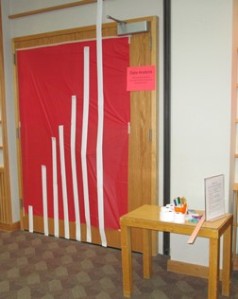
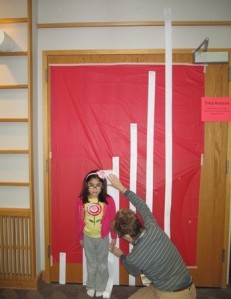

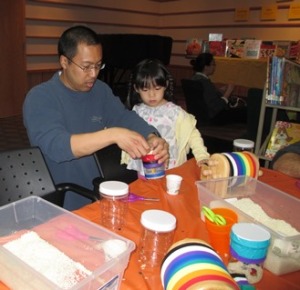
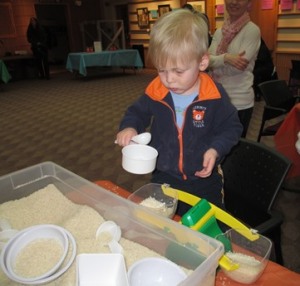
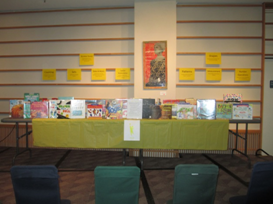
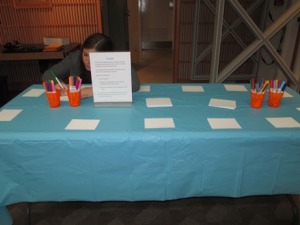
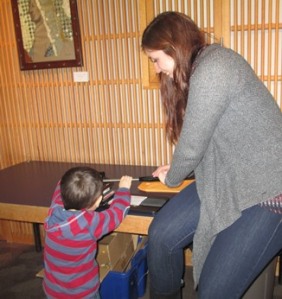
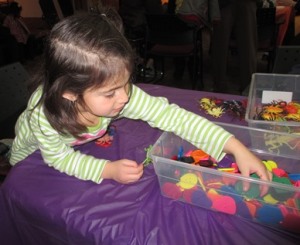
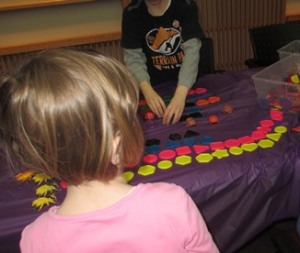
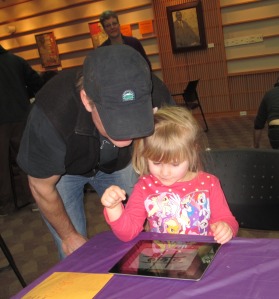
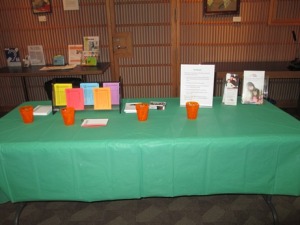
Comments on: "Fun with Math" (7)
I love this!
Thanks! We had a great time. Fun with Science was also super fun – I’ll try to get it posted.
Looks like great fun! Thanks for sharing. If you did it again would you repeat the activities?
I might change the activity at the “Talk” table. It looks great in the pictures, but it wasn’t as much fun in action as I thought it would be. The rest of the activities, I’d definitely do again.
[…] Fun with Math […]
[…] Check it out here: https://intentionalstorytime.wordpress.com/hands-on-science/fun-with-math/ […]
[…] Fun with Math […]